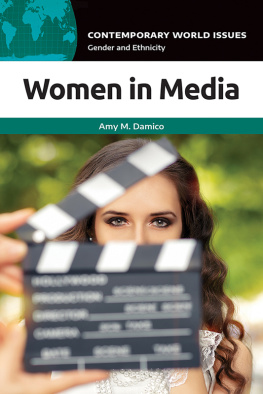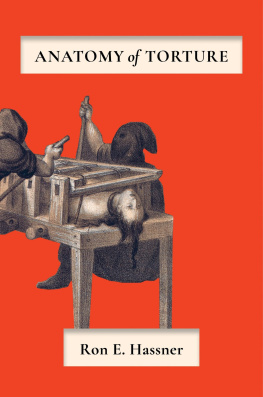Media Representations of Gender and Torture Post-9/11
Routledge Studies in Rhetoric and Communication
1. Rhetorics, Literacies, and Narratives of Sustainability
Edited by Peter Goggin
2. Queer Temporalities in Gay Male Representation
Tragedy, Normativity, and Futurity
Dustin Bradley Goltz
3. The Rhetoric of Intellectual Property
Copyright Law and the Regulation of Digital Culture
Jessica Reyman
4. Media Representations of Gender and Torture Post-9/11
Marita Gronnvoll
Media Representations of Gender and Torture Post-9/11
Marita Gronnvoll

New York London
First published 2010
by Routledge
270 Madison Avenue, New York, NY 10016
Simultaneously published in the UK
by Routledge
2 Park Square, Milton Park, Abingdon, Oxon OX14 4RN
Routledge is an imprint of the Taylor & Francis Group, an informa business
This edition published in the Taylor & Francis e-Library, 2010.
To purchase your own copy of this or any of Taylor & Francis or Routledges collection of thousands of eBooks please go to www.eBookstore.tandf.co.uk.
2010 Taylor & Francis
All rights reserved. No part of this book may be reprinted or reproduced or utilised in any form or by any electronic, mechanical, or other means, now known or hereafter invented, including photocopying and recording, or in any information storage or retrieval system, without permission in writing from the publishers.
Trademark Notice: Product or corporate names may be trademarks or registered trademarks, and are used only for identification and explanation without intent to infringe.
Library of Congress Cataloging-in-Publication Data
Gronnvoll, Marita.
Media representations of gender and torture post-9/11 / by Marita Gronnvoll.
p. cm.(Routledge studies in rhetoric and communication ; 4)
Includes bibliographical references and index.
1. Torture in mass media. 2. Women soldiers in mass media. 3. Sex role in mass
media. 4. Mass mediaUnited States. 5. TortureMoral and ethical aspects
United States. 6. TortureGovernment policyUnited States. I. Title.
P96.T672U654 2010
070.4'49399dc22
2009052847
ISBN 0-203-84867-5 Master e-book ISBN
ISBN13: 978-0-415-87480-9 (hbk)
ISBN13: 978-0-203-84867-8 (ebk)
To my mother, Sylva Gronnvoll
Contents
Figures
2.1 | England with prisoner on a leash. |
2.2 | England and Graner, pyramid photograph. |
2.3 | Graner and Harman, pyramid photograph. |
2.4 | Iraqi prisoners engaged in forced simulated sex. |
2.5 | Iraqi prisoners in forced nude pose. |
2.6 | Anonymous Iraqi woman prisoner. |
2.7 | Iraqi woman prisoner forced to expose herself. |
Acknowledgments
Although my name appears alone on the cover of this book, it is far from a solo endeavor. I can never begin to thank all of the people who helped me along the way from the initial thought to the final words on these pages, but a few must be mentioned for their outstanding love and support. Foremost among these is my brilliant mentor, friend, and colleague Celeste Condit. As the saying goes, she has already forgotten more than Ill ever know, and I am endlessly appreciative that she lent her critical eye and supportive heart to this project. Celeste helped me merge my scholarly and activist voice in a way that I know will benefit me for the rest of my career, and simply made a better person out of me. Thank you. I also owe a debt of gratitude to numerous scholars now at various institutions around the country, but who converged with me for a while at the University of Georgia, and pushed me to continually do better. My thanks to John Murphy, Bonnie Dow, Roger Stahl, Vanessa Beasley, Kelly Happe, and Amy Ross. I thank my colleagues at Eastern Illinois University, especially Carrie Wilson-Brown, Mehdi Semati, Olaf Hoerschelmann, Sherry Holladay, and Tim Coombs, for their assistance as I made the transition from student to published scholar. A bumpy ride was made much smoother by their guidance. And a special thanks to Routledge for taking a chance on me.
This book is the product of many strenuous hours of thinking, writing, and research, and much of it was done during the most difficult time of my lifeas my mother was dying. I thank my friends and family who helped me to focus even when it was nearly impossible. My thanks to my wonderful friend, writing partner, and sister in spirit, Jamie Landau. Thank you for lending me your brain and your shoulder. I love you. I also want to give a special shout-out to Becky Kuehl, one of the Women Who Wine, for the hours of talking and commiseration. Thanks, too, to my oldest friend, Matthew von der Ahe, with whom I spent hours on the phone talking through different concepts as they occurred to me. My family, too, deserves my appreciation, and a few especially deserve special mention. Thanks to my sisters, Rung and Karina, for their brilliant minds and unconditional support, and to my dad, Kurt, who always gave me encouragement and love even during his darkest times. My mom, Sylva, passed away before I finished this project, but she knew where it was going. Id like to think that she would be proud to see the finished product. Mom, I miss you every day.
The issue of torture has preoccupied me for some time, as it has also been a constant preoccupation of media and government. As difficult as it has been to be submerged in this brutal world, even though my experience has been mediated, I am hopeful that things can and will improve. Ultimately, this book is my small contribution to that end.
Interrogating Torture
Whoever was tortured, stays tortured.
Theres no such thing as a little bit of torture.
On April 28, 2004, the CBS news program 60 Minutes II broke the story of prisoner torture at the American-controlled Iraqi prison of Abu Ghraib. Photographic images broadcast by the program showed naked Iraqi male prisoners being subjected to a variety of physical abuses and humiliations, many of them clearly in violation of numerous anti-torture treaties and conventions and Muslim sexual taboos. Posed in a number of the photographs were American servicemen and -women smiling into the camera, and in some cases giving cheerful thumbs-up. The photographic evidence from Abu Ghraib suggested that representatives of the liberating force in Iraq were torturing imprisoned Iraqis with seeming impunity. Condemnation by government and press representatives for the actions of those labeled as the few was swift. President Bush spoke publicly from the White House on April 30th saying, I share deep disgust that those prisoners were treated the way they were treated. Their treatment does not reflect the nature of the American people. Thats not the way we do things in America.









